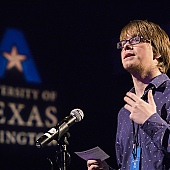Detecting Solutions to Nuclear Threats
Spring 2011 · Comment ·
UT Arlington researchers are working to keep the country safe from nuclear materials. Physics Assistant Professor Wei Chen, physics Professor Andrew Brandt, and their team received more than $1.3 million from the National Science Foundation and the U.S. Department of Homeland Security to develop nanoparticles for radiation detection. Their research could lead to a new type of detector that would help reduce the threat of nuclear materials brought into the country illegally and used in terrorism. “The broader impact of this proposal is potentially enormous,”
Dr. Chen says. “Development of more effective uranium detection devices could be of immeasurable benefit to society if it were to help deter or prevent a nuclear incident.” With Chen and Brandt as co-principal investigators, the team is developing polymer thin films embedded with luminescent nanoparticles that will glow with light when they encounter radiation sources, such as gamma rays. Chen says the new detection method is easier to build and more accurate than current luminescent devices. “The unique aspect of this proposal is that the nanoparticles are formed into hybrid ‘crystals’ that combine the high stopping power and excellent energy resolution of crystals with the potentially high quantum efficiency and short decay lifetimes associated with nanoparticles,” Dr. Brandt says. Once tested and demonstrated, the new detectors could cost about $25 for a crystal that’s one centimeter wide and 10 centimeters long. The project includes an educational outreach component. Lectures, seminars, and an annual symposium are planned to spark student interest in research and promote the idea that nanotechnology, high-energy physics, and nuclear engineering can work in concert to improve homeland security.




















